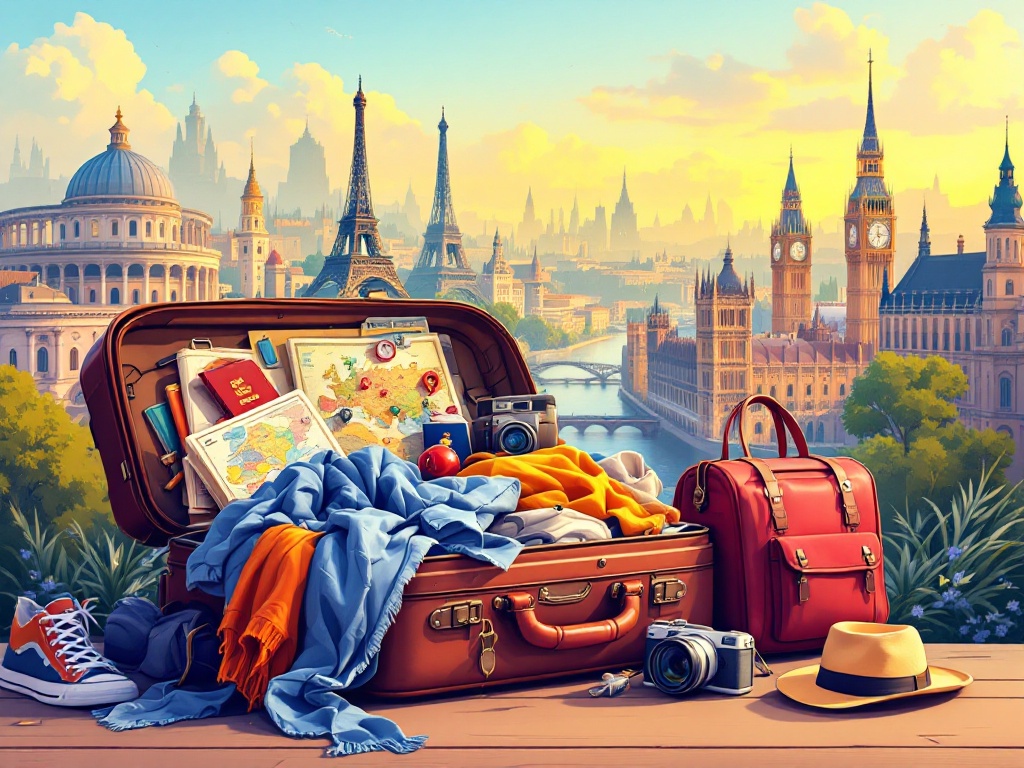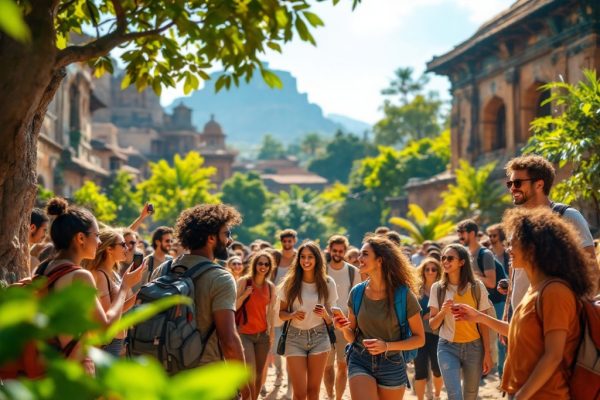Travel to Europe: Essential Tips
Dreaming of a European adventure? Ensure your trip is smooth and memorable with our essential travel guide. From securing a valid passport and visa to packing smart and navigating local customs, we cover everything you need. Discover tips on finding the best deals on flights and accommodations, exploring off the beaten path, and staying safe. Start planning your dream European getaway today!
Important information

- Passport and Visa: Ensure your passport is valid for at least six months after your return date. Check visa requirements for your nationality and destination.
- Travel Insurance and Medical Kit: Obtain comprehensive travel insurance covering medical emergencies, cancellations, and lost luggage. Pack a basic medical kit with essential medications and first-aid supplies.
- Accommodation and Flights: Book flights and accommodations in advance, especially during peak season, for better deals and availability. Consider budget airlines and alternative accommodations like hostels or vacation rentals.
- Safety and Security: Be vigilant about your belongings in crowded areas. Avoid displaying valuables, research your destination’s safety, and keep emergency contact information handy.
- Local Culture: Learn basic phrases in the local language and research local customs to enhance your experience and show respect. Explore local cuisine and cultural events.
Essential Travel Documents and Preparations
Planning a trip abroad? Here’s what you need to prepare:
Ensure your passport’s validity. Check that your passport has at least six months of validity remaining after your planned return date.
Visa requirements. Depending on your nationality and the length of your stay, certain European countries may require a visa. Research the specific visa regulations for your destination.
Travel insurance. Obtaining travel insurance is highly recommended. It can provide coverage for unexpected medical emergencies, trip cancellations, or lost luggage.
Medical kit. Prepare a basic medical kit containing essential medications and first-aid supplies. This will help you manage minor health issues during your travels.
Document copies. Photocopy your passport, visa, and travel insurance policy. Store these copies separately from the original documents in case of loss or theft.
Passport and Entry Requirements
Traveling to Europe requires a valid passport. Its expiration date must comply with each country’s specific regulations. Additionally, a visa may be necessary depending on your citizenship and the destination country.
Travel Insurance and Medical Needs
Travel insurance is essential for protecting yourself from unforeseen issues. A comprehensive policy offers several key benefits: it reimburses your prepaid expenses if you cancel for a covered reason, such as illness or a natural disaster, it offers crucial medical coverage abroad, especially if your health insurance doesn’t extend internationally, and it covers lost or stolen luggage. Some policies even assist with flight delays. Beyond insurance, remember to pack a small medical kit with essentials. This should include pain relievers, antidiarrheal medication, antiseptic wipes, and bandages. Most importantly, remember any personal prescriptions you require.
Financial Preparations and Security
- Notify your bank of your travel plans to avoid any card issues.
- Cash is useful for small purchases and souvenirs.
- Make copies of important documents and store them securely.
Making Reservations and Planning Ahead
Secure your trip by booking flights and accommodations early, especially during peak season. This guarantees your travel plans and provides peace of mind.
Packing Tips for Your European Adventure
Pack light clothing that can be layered to easily adapt to changing weather conditions. Comfortable walking shoes are essential for exploring European cities. Stay hydrated by bringing a reusable water bottle. A universal adapter will ensure you can charge your devices. Remember toiletries and any necessary medications. A small first-aid kit is always a wise precaution. Keep important documents, such as your passport and visa, secure yet readily accessible.
- Pack light clothing that can be layered.
- Comfortable walking shoes are essential.
- Bring a reusable water bottle to stay hydrated.
- A universal adapter will ensure you can charge your devices.
- Remember toiletries and any necessary medications.
- A small first-aid kit is a wise precaution.
- Keep important documents secure yet readily accessible.
Must-Have Packing Items
Comfortable walking shoes are essential for exploring Europe’s charming cities and towns, as you’ll be doing a lot of walking. A reusable water bottle is a must-have to stay hydrated throughout your adventures. Packing layers of clothing is wise, given Europe’s unpredictable weather. Your passport and any required visas are absolutely crucial. Make copies of these important documents for safety.
- Comfortable walking shoes,
- Reusable water bottle,
- Layered clothing,
- Passport and visas,
- Copies of travel documents.
A universal travel adapter is essential for keeping your phone and other devices charged. A lightweight rain jacket or umbrella is a good precaution against unpredictable weather. A small first-aid kit with bandages and pain relievers can be incredibly helpful. Lastly, a lightweight daypack is perfect for carrying essentials on day trips.
- Universal travel adapter,
- Lightweight rain jacket or umbrella,
- Small first-aid kit,
- Lightweight daypack.
Clothing and Footwear Advice
Pack clothes that can be layered. Dark wash jeans and light t-shirts are ideal for versatile outfits. Comfortable shoes are essential for exploring, while sandals or flip-flops are great for warmer days. However, given the unpredictable weather, a lightweight rain jacket and an umbrella are must-haves to stay dry.
Weather Considerations and Accessories
Planning a European trip? Check the forecast and pack smart! Here’s a list of essentials:
- Raincoat and umbrella: essential for wet weather.
- Light jacket: always handy for layering.
- Comfortable walking shoes: crucial for exploring charming streets.
- Reusable water bottle: stay hydrated on the go.
- Small first-aid kit: prepare for minor mishaps.
- European power adapter: keep your devices charged.
Electronics and Gadgets to Bring
- immortalize your travels with a camera, preserving those precious memories.
- pack a reusable water bottle to minimize your plastic footprint.
- european adventurers should remember a universal power adapter to keep devices charged.
- a portable charger is another essential item, ensuring your electronics never run out of juice on the go.
Transportation Tips for Europe
Traveling within Europe offers diverse transportation options, each with its own advantages. For longer distances, flying is often the most efficient choice. Budget airlines provide competitive fares, especially when booked in advance, particularly during peak travel seasons. Comparing prices and flight times across different airlines ensures you secure the best deal. Consider checking multiple airline websites and travel aggregators to find the most economical option.
Public Transportation
Europe is renowned for its comprehensive public transportation systems. Many cities offer integrated metro, bus, and tram networks, providing convenient and cost-effective travel. Purchasing a travel pass often simplifies journeys and reduces overall expenses. Pre-planning routes and consulting timetables is highly recommended to optimize travel time. Always validate your ticket upon boarding to avoid potential fines.
Car Rentals
Renting a car allows for independent exploration of the countryside at your own pace. However, remember that driving regulations and road conditions can vary significantly between countries. Automatic transmissions may be less common and incur higher costs. Factor in potential parking fees and tolls, which can be substantial in some areas. An International Driving Permit might also be necessary depending on your country of origin.
Booking International and Local Flights
Planning your European adventure? Booking your flights in advance, especially for international travel, is key to securing the best deals. Early birds often catch the lowest fares and have a wider selection of flight times. For travel between European cities, consider budget airlines for greater savings. Utilize comparison websites and apps like Skyscanner, Google Flights, and Kayak to find the perfect deal. These tools compare prices from various airlines, ensuring you get the best value for your money.
Getting Around with Public Transport
Traveling within European cities is both convenient and budget-friendly, thanks to their comprehensive public transportation systems. Trams, subways, and buses are easily accessible, simplifying city exploration. Planning ahead and researching the local transport network before your trip is highly recommended for seamless travel. If you plan on using public transport frequently, consider purchasing a travel pass for optimal value and cost savings.
Consider Renting a Car
A rental car offers unparalleled freedom for exploring the countryside and hopping between European cities. Before you hit the road, though, ensure your driver’s license is valid and up-to-date.
Efficient and affordable buses, trams, and subways make city travel a breeze. For a different perspective, explore cities by bike, rideshare, or walking tour.
While a car is great for rural travel, public transport shines in urban areas. Trains are a speedy option for intercity journeys, while buses provide a budget-friendly alternative, especially for longer distances.
Accommodation and Reservations
Booking accommodations online offers incredible convenience and often better deals. When selecting a hotel, hostel, or apartment, consider the location and amenities. Don’t forget to check guest reviews. For a unique experience, explore guesthouses. If you prefer a local touch, consider a bed and breakfast. Vacation rentals are another excellent option.
Find the perfect accommodation
Evaluate these alternatives based on your travel style and budget:
- hotels,
- hostels,
- apartments,
- guesthouses,
- bed and breakfasts,
- vacation rentals.
Key Considerations
- Location: Choose a location that aligns with your itinerary and interests,
- Amenities: Determine which amenities are essential for your comfort and convenience,
- Guest reviews: Read reviews from previous guests to gain insights into the accommodation’s strengths and weaknesses.
Booking Hotels and Other Lodgings
When booking accommodations, consider these key factors: location, price, and amenities. Reading reviews can be invaluable in finding the perfect fit for your needs. Don’t limit yourself to traditional hotels. Explore unique options such as hostels and guesthouses for a more social or budget-friendly experience. Consider vacation rentals for potentially more immersive experiences and budget flexibility.
Alternative Accommodations
Looking for unique and budget-friendly travel accommodations? Consider these options:
- Hostels: Perfect for budget travelers, hostels offer dorm-style rooms and shared common areas, providing opportunities to connect with other adventurers.
- Vacation Rentals: Ideal for those seeking more space and amenities, vacation rentals such as apartments and houses often include kitchens, laundry facilities, and separate living areas.
- Homestays: For a truly immersive cultural experience, choose a homestay and live with a local family. This offers an unparalleled opportunity to learn about local customs, traditions, and daily life.
Understanding Local Culture and Customs
Learning key phrases in the local language not only aids communication, but also shows respect. Researching local customs, such as greetings and dining etiquette, will help you navigate social situations with ease.
- Explore local cuisine.
- Attend cultural events.
- Visit historical sites.
Experiences like these offer valuable immersion and foster a deeper understanding. Be mindful of local traditions and engage respectfully with the community. This enriches your travel experience and promotes cultural exchange.
- Research local customs and norms, such as greetings, dining etiquette, and tipping practices.
- Explore local cuisine and cultural events through activities like attending festivals, sampling regional dishes and visiting historical sites.
- Engage respectfully with the community.
Learning Key Phrases in Local Languages
Learning basic phrases like “hello,” “thank you,” and “excuse me” demonstrates respect and facilitates communication. Knowing how to ask for directions, order food, or request assistance can be incredibly helpful. Consider using translation apps or phrasebooks.
Researching Customs and Local Norms
Showing respect for local customs can greatly improve your travel experience. One way to do this is by learning common greetings, which can vary from handshakes in some European countries to cheek kisses in others. Dining etiquette also differs significantly around the world, so it’s a good idea to research local customs regarding utensil use, appropriate attire, and tipping practices. Learning basic phrases in the local language can help bridge cultural gaps and foster connections with residents. Finally, be mindful of personal space and avoid loud conversations in public places, demonstrating consideration for those around you.
Learn customary greetings. These can range from handshakes to cheek kisses, depending on the region.
Research dining etiquette. Understand local customs related to utensil use and dress codes.
Understand tipping practices. Knowing how much to tip can avoid awkward situations and shows respect for local customs.
Learn basic phrases. Even a few words in the local language can go a long way in building rapport with locals.
Be mindful of personal space. Avoid loud conversations in public and be considerate of those around you.
Exploring Local Cuisine and Cultural Events
Food tours offer a fantastic way to experience local cuisine and culture. They guide you through tastings at authentic restaurants, vibrant street food stalls, and bustling markets. Some even include hands-on cooking classes led by local chefs.
Engaging with cultural events enriches your travel experience. For example, watching traditional Filipino dances in Manila offers a glimpse into the country’s heritage. Similarly, exploring venues like the Cultural Center of the Philippines or the Ayala Museum provides a deeper understanding of Filipino arts and history.
Culinary tours provide a similar deep dive into the local food scene. These might involve cooking classes, restaurant tastings, farm visits, or even excursions to historical sites and local festivals.
These immersive experiences create lasting memories, connecting you to the heart and soul of a place.
Safety and Security Tips
Traveling safely requires vigilance. Avoid displaying valuable items like jewelry or electronics to deter theft and scams. Prior research on your destination’s safety and using reliable transportation are crucial. Keep local emergency numbers and your embassy’s contact information readily available. If a situation feels unsafe, trust your instincts and remove yourself. Copying important documents, such as your passport and travel insurance, provides an extra layer of security.
Safety Precautions for Travelers
- Avoid displaying valuable items, such as jewelry or electronics, to deter theft and scams.
- Research your destination’s safety and use reliable transportation.
- Keep local emergency numbers and your embassy’s contact readily available.
- Trust your instincts and remove yourself from unsafe situations.
- Copy important documents, like your passport and travel insurance, for extra security.
Navigating Tourist Destinations
Tourist destinations often present unique challenges. Anticipate large crowds, inflated prices, and potential language barriers. Protect your belongings and maintain heightened awareness, particularly in congested areas.
Avoiding Common Scams and Pickpockets
Stay vigilant in crowded areas like public transport and tourist attractions, as these are common targets for pickpockets, often working in groups. Be cautious of distractions, such as staged incidents or petition requests, which can be used to divert your attention while someone steals your belongings. Avoid suspiciously cheap offers from street vendors; if a deal seems too good to be true, it probably is. Report any scams or thefts to local authorities immediately. Always be aware of your surroundings.
Managing Expectations in Tourist Areas
Traveling to Europe’s top tourist spots? Be prepared for crowds, especially during peak season. Long queues at attractions, restaurants, and transport hubs are common, leading to potential delays. Planning ahead is key for a smoother experience. Booking tickets in advance, for example, can save you valuable time. While some delays are inevitable, accepting this can reduce stress. Consider traveling during the shoulder seasons (spring or fall) for fewer crowds.
Tips for a Smoother Trip
- Book tickets in advance to save time.
- Travel during shoulder seasons (spring or fall) for fewer crowds.
Managing Expectations
- Expect long queues at popular attractions, restaurants, and transport hubs.
- Accept that some delays are unavoidable, even with planning.
Additional Tips for First-Time Travelers to Europe
Packing for your European adventure requires a layered approach to clothing, allowing you to adapt to varying weather conditions. Pack a lightweight raincoat and umbrella for sudden showers. Waterproof shoes are advisable, especially during spring and autumn. For winter travel, pack warm coats, hats, gloves, and scarves. Summer packing should prioritize lighter clothing, sunscreen, and a hat.
Enhance Your European Experience
To truly immerse yourself in European culture, venture beyond the well-trodden tourist paths. Explore charming smaller towns and villages for an authentic taste of local life.
- Discover local festivals for unique cultural insights.
- Utilize local buses or trains to reach less-traveled areas.
- Engage with locals to uncover hidden gems and local recommendations.
Practical Packing Tips
Layering is key to adapt to Europe’s diverse weather. A lightweight raincoat and umbrella are essential for unpredictable showers.
- Waterproof shoes are highly recommended, especially during spring and autumn.
- For winter trips, pack warm coats, hats, gloves, and scarves.
- Prioritize lighter clothing, sunscreen, and a hat for summer travel.
Planning for All Seasons
Spring (March-May)
Spring offers pleasant weather and vibrant blossoms. Pack light layers to accommodate fluctuating temperatures.
Summer (June-August)
Summer, the peak season, boasts warm weather ideal for outdoor adventures. Remember swimwear, light clothing, and sunscreen.
Autumn (September-November)
Autumn arrives with crisp air and stunning foliage. Layering is essential, including a light jacket.
Winter (December-February)
Winter can be chilly, particularly in northern Europe. Pack warm clothing like a heavy coat, hat, gloves, and scarf.
Before your trip, research your specific destinations, checking average temperatures, rainfall, and any unique seasonal events or festivals.
Traveling Off the Tourist Trail
Venture beyond Europe’s typical tourist attractions and discover hidden gems. Explore quaint towns and villages, connect with locals, and savor authentic regional cuisine. These experiences offer a genuine taste of European culture, creating unforgettable travel memories. Embrace the unexpected and craft your own unique European adventure.












